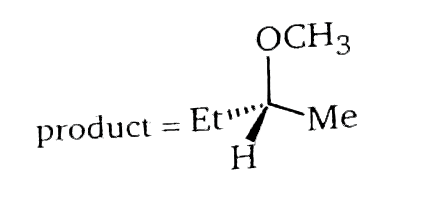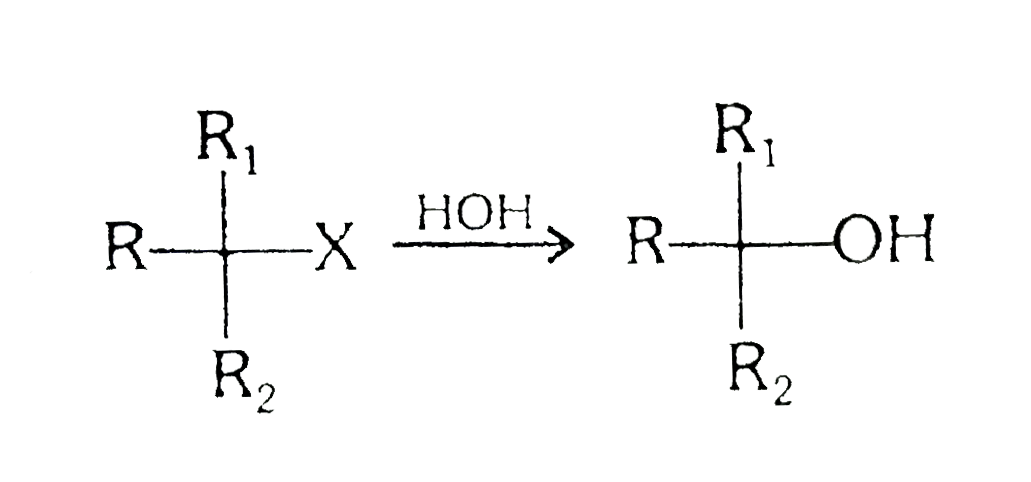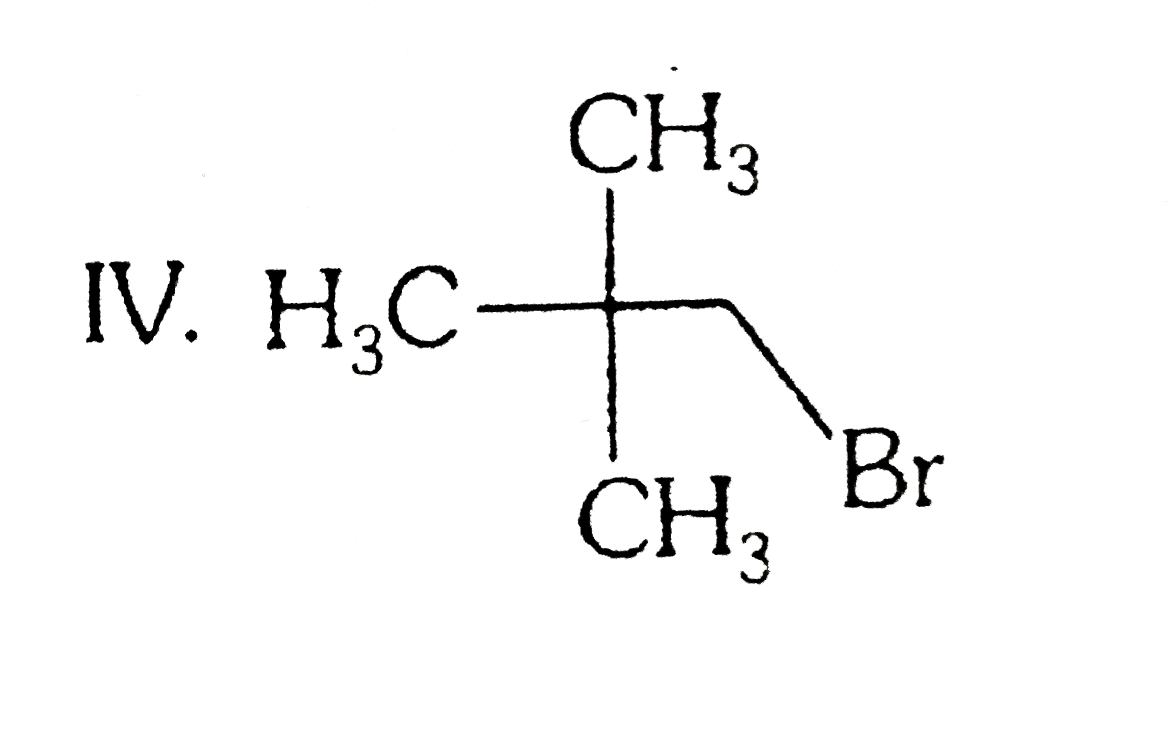The SN2 reaction involves back - side attack and therefore results in a ''Walden Inversion.'' For which one of the substrates shown would you be able to demonstrate that such back - side attack with ''Walden Inversion'' has infact occurred?
1 - bromopropane
2 - bromobutane
3 - bromopentane
Methyl bromide
The correct Answer is:B
To determine which substrate would demonstrate a Walden inversion during an SN2 reaction, we need to analyze the chirality of the substrates provided. The SN2 reaction involves a backside attack by the nucleophile, leading to an inversion of configuration at the chiral center. Here’s a step-by-step breakdown of how to identify the correct substrate:
Step 1: Understand the SN2 Mechanism
- The SN2 (Substitution Nucleophilic Bimolecular) reaction is characterized by a single step where the nucleophile attacks the substrate from the opposite side of the leaving group.
- This backside attack results in a geometric inversion known as Walden inversion.
Hint: Remember that for a Walden inversion to occur, the carbon atom attached to the leaving group must be chiral.
Step 2: Identify Chiral Centers
- A chiral center is a carbon atom that is bonded to four different substituents. Only chiral centers can exhibit Walden inversion.
- Examine each substrate to check if the carbon atom bonded to the halogen (in this case, bromine) is chiral.
Hint: Look for a carbon atom bonded to four different groups or atoms.
Step 3: Analyze the Given Substrates
- 1-Bromopropane: The carbon attached to bromine is bonded to two hydrogen atoms and two other groups (not chiral).
- 2-Bromobutane: The carbon attached to bromine is bonded to an ethyl group, a methyl group, a hydrogen atom, and the bromine (chiral).
- 2-Bromopentane: Similar to 2-bromobutane, but check if the carbon is still chiral.
- Methyl Bromide: The carbon attached to bromine is bonded to three hydrogen atoms (not chiral).
Hint: Identify which of the substrates has a chiral carbon atom.
Step 4: Confirm the Presence of Walden Inversion
- For the substrate to demonstrate Walden inversion, it must undergo the SN2 reaction with a chiral center.
- In the case of 2-bromobutane, when the nucleophile attacks from the backside, it will lead to an inversion of configuration from R to S or vice versa.
Hint: Remember that only the substrate with a chiral center can show Walden inversion.
Conclusion
Based on the analysis, 2-bromobutane is the only substrate that can demonstrate a Walden inversion due to the presence of a chiral carbon atom.
Final Answer
The substrate that would demonstrate backside attack with Walden inversion is 2-bromobutane.
- The SN2 (Substitution Nucleophilic Bimolecular) reaction is characterized by a single step where the nucleophile attacks the substrate from the opposite side of the leaving group.
- This backside attack results in a geometric inversion known as Walden inversion.
- A chiral center is a carbon atom that is bonded to four different substituents. Only chiral centers can exhibit Walden inversion.
- Examine each substrate to check if the carbon atom bonded to the halogen (in this case, bromine) is chiral.
- 1-Bromopropane: The carbon attached to bromine is bonded to two hydrogen atoms and two other groups (not chiral).
- 2-Bromobutane: The carbon attached to bromine is bonded to an ethyl group, a methyl group, a hydrogen atom, and the bromine (chiral).
- 2-Bromopentane: Similar to 2-bromobutane, but check if the carbon is still chiral.
- Methyl Bromide: The carbon attached to bromine is bonded to three hydrogen atoms (not chiral).
- For the substrate to demonstrate Walden inversion, it must undergo the SN2 reaction with a chiral center.
- In the case of 2-bromobutane, when the nucleophile attacks from the backside, it will lead to an inversion of configuration from R to S or vice versa.
Based on the analysis, 2-bromobutane is the only substrate that can demonstrate a Walden inversion due to the presence of a chiral carbon atom.
The substrate that would demonstrate backside attack with Walden inversion is 2-bromobutane.
Similar Questions
SN2 reaction is a bimolecular reaction which takes places by the formation of T.S. Veolcity of the reaction depends on the concentration of the substrate as well as the nucleophile.
The reaction is favoureed by strong Nuo− and in the presence of polar aprotic sovlent, optically active halides give. Walden inversion by SN2 mechanism. The presence of hetro group (atom) at β−C atom, unsaturation at β−C and ⎛⎜ ⎜⎝−O∣∣C−⎞⎟ ⎟⎠ group at α−C atomn favor SN2 mechanism.
Allyl halides and benzyl halides give SN1 and SN2 reactions. Allyl halides alos give SN2 mechanism EDG at ortho- and para- postions in benzyl halides favors SN1 mechanism, wheras EWG favors SN2 mechanism.
Which of the following will gives SN2 mechanism gtView SolutionThe back side attack on -- bromobutan by methoxide (CH3O−) gives the product shown below j. which fischer projeaction represents 2-bromobutane used a sthe reactant in this raction ?
 View Solution
View Solution
Knowledge Check
- Question 1 - Select One
A Little to the Left, but Not Too Much!
Italy’s Tower of Pisa has been leaning southward since the initial 12 stages of it’s––––––––––––– construction over 800 years ago. 13 Indeed,–––––––– if the tower’s construction had not taken two centuries and involved significant breaks due to war and civil unrest, which allowed the ground beneath the tower to settle, the tower would likely have collapsed before it was completed.
Luckily, the tower survived, and its tilt has made it an Italian 14 icon, it attracts––––––––––––––––– visitors from all over who flock to Pisa to see one of the greatest architectural 15 weirdnesses––––––––––––– in the world. 16 By the late twentieth century, the angle of the tower’s tilt had reached an astonishing 5.5 degrees, in 17 1990, Italy’s government closed–––––––––––––––––––––––––––––––––– the tower to visitors and appointed a committee to find a way to save it.
The committee was charged with saving the tower without ruining its aesthetic, 18 which no one had yet managed to achieve.–––––––––––––––––––––––––––––––––––––––––––––– The committee’s first attempt to reduce the angle of the tower’s tilt—placing 600 tons of iron ingots (molded pieces of metal) on the tower’s north side to create a counterweight—was derided because the bulky weights ruined the tower’s appearance. The attempt at a less visible solution—sinking anchors into the ground below the tower—almost caused the tower to fall.
[1] Enter committee member John Burland, 19 he is––––– a geotechnical engineer from England who saved London’s clock tower Big Ben from collapse. [2] Burland began a years-long process of drilling out small amounts of soil from under the tower 20 that took several years to complete–––––––––––––––––––––––––––––––––––––– and then monitoring the tower’s resulting movement. [3] Twice daily, Burland evaluated these movements and made recommendations as to how much soil should be removed in the next drilling. [4] By 2001, almost 77 tons of soil had been removed, and the tower’s tilt had decreased by over 1.5 degrees, the ugly iron weights were removed, and the tower was reopened to visitors. [5] Burland 21 advocated using–––––––––––––––––– soil extraction: removing small amounts of soil from under the tower’s north side, opposite its tilt, to enable gravity to straighten the tower. 22
The tower’s tilt has not increased since, and the committee is confident that the tower will be safe for another 200 years. Burland is now working on a more permanent solution for keeping the tower upright, but he is adamant that the tower never be completely straightened. In an interview with PBS’s Nova, Burland explained that it is very important “that we don’t really change the character of the monument. That would be quite wrong and quite inappropriate.”ANO CHANGEBicon, attractingCicon, its attractingDicon, attracting - Question 2 - Select One
A Little to the Left, but Not Too Much!
Italy’s Tower of Pisa has been leaning southward since the initial 12 stages of it’s––––––––––––– construction over 800 years ago. 13 Indeed,–––––––– if the tower’s construction had not taken two centuries and involved significant breaks due to war and civil unrest, which allowed the ground beneath the tower to settle, the tower would likely have collapsed before it was completed.
Luckily, the tower survived, and its tilt has made it an Italian 14 icon, it attracts––––––––––––––––– visitors from all over who flock to Pisa to see one of the greatest architectural 15 weirdnesses––––––––––––– in the world. 16 By the late twentieth century, the angle of the tower’s tilt had reached an astonishing 5.5 degrees, in 17 1990, Italy’s government closed–––––––––––––––––––––––––––––––––– the tower to visitors and appointed a committee to find a way to save it.
The committee was charged with saving the tower without ruining its aesthetic, 18 which no one had yet managed to achieve.–––––––––––––––––––––––––––––––––––––––––––––– The committee’s first attempt to reduce the angle of the tower’s tilt—placing 600 tons of iron ingots (molded pieces of metal) on the tower’s north side to create a counterweight—was derided because the bulky weights ruined the tower’s appearance. The attempt at a less visible solution—sinking anchors into the ground below the tower—almost caused the tower to fall.
[1] Enter committee member John Burland, 19 he is––––– a geotechnical engineer from England who saved London’s clock tower Big Ben from collapse. [2] Burland began a years-long process of drilling out small amounts of soil from under the tower 20 that took several years to complete–––––––––––––––––––––––––––––––––––––– and then monitoring the tower’s resulting movement. [3] Twice daily, Burland evaluated these movements and made recommendations as to how much soil should be removed in the next drilling. [4] By 2001, almost 77 tons of soil had been removed, and the tower’s tilt had decreased by over 1.5 degrees, the ugly iron weights were removed, and the tower was reopened to visitors. [5] Burland 21 advocated using–––––––––––––––––– soil extraction: removing small amounts of soil from under the tower’s north side, opposite its tilt, to enable gravity to straighten the tower. 22
The tower’s tilt has not increased since, and the committee is confident that the tower will be safe for another 200 years. Burland is now working on a more permanent solution for keeping the tower upright, but he is adamant that the tower never be completely straightened. In an interview with PBS’s Nova, Burland explained that it is very important “that we don’t really change the character of the monument. That would be quite wrong and quite inappropriate.”ANO CHANGEBTherefore,CNevertheless,DHowever,
Nucleophilic aliphatic substitution reaction is mainly of two types: SN1 and SN2. The SN1 mechanism is a two step process. Reaction velocity of SN1 reaction depends only on the concentration of the substrate. Since product formation takes place by the formation of carbocation, optically active substrate gives (+) and (-) forms of the product. In most of the cases the product usually consits of 5−20% inverted product and 80−95% racemised species. The more stable the carbocation, the greater is the proportion of racemisation. In solvolysis reaction, the more nucleophilic the solvent, the greater is the proportion of inversion.
Which one of the following compound will give SN1 reaction predominantly?View SolutionNucleophilic aliphatic substitution reaction is mainly of two types: SN1 and SN2. The SN1 mechanism is a two step process. Reaction velocity of SN1 reaction depends only on the concentration of the substrate. Since product formation takes place by the formation of carbocation, optically active substrate gives (+) and (-) forms of the product. In most of the cases the product usually consits of 5−20% inverted product and 80−95% racemised species. The more stable the carbocation, the greater is the proportion of racemisation. In solvolysis reaction, the more nucleophilic the solvent, the greater is the proportion of inversion.
For the gives reaction,
Which substrate will give maximum racemisation?View SolutionSN2 reaction is a bimolecular reaction which takes places by the formation of T.S. Veolcity of the reaction depends on the concentration of the substrate as well as the nucleophile.
The reaction is favoureed by strong Nuo− and in the presence of polar aprotic sovlent, optically active halides give. Walken inversion by SN2 mechanism. The presence of hero group (atom) at β−C atom, unsaturation at β−C and ⎛⎜ ⎜⎝−O∣∣C−⎞⎟ ⎟⎠ group at α−C atomn favor SN2 mechanism.
Allyl halides and benzyl halides give SN1 and SN2 reactions. Allyl halides alos give SN2 mechanism EDG at ortho- and para- postions in benzyl halides favors SN1 mechanism, wheras EWG favors SN2 mechanism.
Which of the following will give Walden inversion ?View SolutionOptically pure (+)−2 -chlorooctane, [α]=+40∘, reacts with aq. NaOH in acetone to give optically pure (−)−2 -octanol, [α]=−12.0∘. With partically racemised chloro compound whose [α]=+30∘, the [α] of alcohal product is −6.0∘. Calculate :
(a) The percentage optical purity of partially racemised chloro compound and alcohol.
(b) The percentage of inversion and racemisation.
(c) The percentage of front-side and back-side attacks.
(d) What interference can be drawn from the data in part (a) of the above example, about the mode of 2∘ alky1 halide.
( e) Give the rate expression.
In terms if the expression, decrease the experimental changes for encourage (i) SN1, (ii) SN2,View SolutionNucleophilic aliphatic substitution reaction is mainly of two types: SN1 and SN2. The SN1 mechanism is a two step process. Reaction velocity of SN1 reaction depends only on the concentration of the substrate. Since product formation takes place by the formation of carbocation, optically active substrate gives (+) and (-) forms of the product. In most of the cases the product usually consits of 5−20% inverted product and 80−95% racemised species. The more stable the carbocation, the greater is the proportion of racemisation. In solvolysis reaction, the more nucleophilic the solvent, the greater is the proportion of inversion.
Which of the following compounds will give SN1 and SN2 reactions with considerable rate?
I. C6H5−CH2−Br (II) CH2=CH−CH2−Br (III) CH3−CH(Br)CH3 (IV)
Select the correct answer from teh codes given belowView SolutionThe rate law expresison is given for a typical reaction, n1A+n2B→P as r=k[A]n[B]n2. The reaction completes only in one step and A and B are present in the solution. If the reaction occurs in more than one step, then the rate law is expressed by consdering the slowest step, i.e., for SNl reaction r=k[RX]. If the eraction occurs in more than one step and the rates of the steps involved are comparable, then steady state approximation is conisdered, i.e., the rate of formation of intermediate is always equal to the rate of decompoistion of the intermediate. Conisder the reaction:
⎡⎢ ⎢⎣I2k2⇐⇒k12I(rapid equilibrium)H2+2Ik3−−→2HI(slow)⎤⎥ ⎥⎦
Which of the following expresison is correct?View Solution

